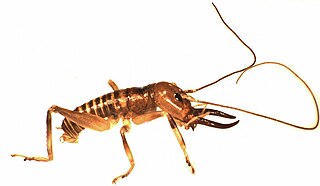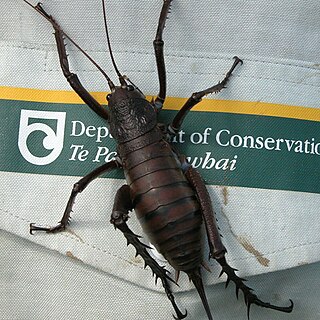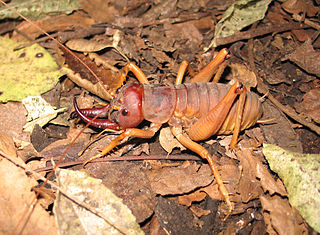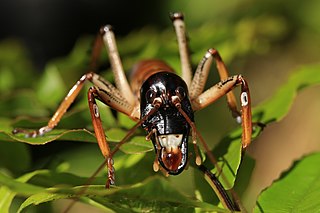
Anostostomatidae is a family of insects in the order Orthoptera, widely distributed in the southern hemisphere. It is named Mimnermidae or Henicidae in some taxonomies, and common names include king crickets in Australia and South Africa, and wētā in New Zealand. Prominent members include the Parktown prawn of South Africa, and the giant wētā of New Zealand. The distribution of this family reflects a common ancestry before the fragmenting of Gondwana.
An ecological island is a term used in New Zealand, and increasingly in Australia, to refer to an area of land isolated by natural or artificial means from the surrounding land, where a natural micro-habitat exists amidst a larger differing ecosystem. In New Zealand the term is used to refer to one of several types of nationally protected areas.

Giant wētā are several species of wētā in the genus Deinacrida of the family Anostostomatidae. Giant wētā are endemic to New Zealand and all but one species are protected by law because they are considered at risk of extinction.

Hemiandrus is a genus of wētā in the family Anostostomatidae. In New Zealand they are known as ground wētā due to their burrowing lifestyle. Hemiandrus wētā are nocturnal, and reside in these burrows during the day. Ground wētā seal the entrance of their burrow during the day with a soil plug or door so that their burrow is concealed. This genus was originally said to be distributed in Australia and New Zealand, however, with recent molecular genetic methods, this is under debate. Ground wētā adults are smaller than other types of wētā, with the unusual trait of having both long and short ovipositors, depending on the species. The name of this genus is said to come from this trait as hemi- mean half and -andrus means male, as the species where the female has a short ovipositor can sometimes be mistaken for a male. This genus has a diverse diet, depending on the species.

The Northland tusked wētā, Anisoura nicobarica, is a rare monotypic wētā of the family Anostostomatidae, endemic to the northern half of Northland in New Zealand, and originally described in 1932. The type specimen was wrongly labelled as coming from the Nicobar Islands, so the species was named Anisoura nicobarica. It was erroneously described again in 1950 by a different author, who placed it in the ground wētā genus Hemiandrus.

Deinacrida fallai or the Poor Knights giant wētā is a species of insect in the family Anostostomatidae. It is endemic to the Poor Knights Islands off northern New Zealand. D. fallai are commonly called giant wētā due to their large size. They are one of the largest insects in the world, with a body length measuring up to 73 mm. Their size is an example of island gigantism. They are classified as vulnerable by the IUCN due to their restricted distribution.

Deinacrida heteracantha, also known as the Little Barrier giant wētā or wētāpunga, is a wētā in the order Orthoptera and family Anostostomatidae. It is endemic to New Zealand, where it survived only on Little Barrier Island, although it has been translocated to some other predator-free island conservation areas. This very large flightless wētā mainly feeds at night, but is also active during the day, when it can be found above ground in vegetation. It has been classified as vulnerable by the IUCN due to ongoing population declines and restricted distribution.

Deinacrida parva is a species of insect in the family Anostostomatidae, the king crickets and weta. It is known commonly as the Kaikoura wētā or Kaikoura giant wētā. It was first described in 1894 from a male individual then rediscovered in 1966 by Dr J.C. Watt at Lake Sedgemore in Upper Wairau. It is endemic to New Zealand, where it can be found in the northern half of the South Island.

Deinacrida rugosa, commonly called the Cook Strait giant weta or Stephens Island weta, is a species of insect in the family Anostostomatidae. The scientific name Deinacrida means "terrible grasshopper" and rugosa means "wrinkled". It is endemic to New Zealand.

Deinacrida connectens, often referred to as the alpine scree wētā, is one of New Zealand's largest alpine invertebrates and is a member of the Anostostomatidae family. Deinacrida connectens is a flightless nocturnal insect that lives under rocks at high elevation. Mountain populations vary in colour. This species is the most widespread of the eleven species of giant wētā (Deinacrida).

Deinacrida carinata, also known as the Herekopare wētā or Foveaux wētā is one of the smallest of the 11 species of giant wētā that belong to the genus Deinacrida, and is a member of the family Anostostomatidae. It is endemic to New Zealand and is currently restricted to a few offshore predator free islands: Herekopare Island, Kundy Island, Tihaka/Pig Island and Whenua Hou/Codfish Island. D.carinata is a protected species and is nationally endangered.
Deinacrida tibiospina, also known as the Mt Arthur giant wētā or the Nelson alpine giant wētā, is a species of wētā in the family Anostostomatidae. It is endemic to the South Island of New Zealand. The wētā is only found in some alpine zones of Kahurangi National Park. Compared with natural densities of other wētā, D. tibiospina is fairly rare. Little conservation effort has been made for this species because, despite its elusiveness, populations on the mainland have been maintained without human intervention.

Deinacrida mahoenui, the Mahoenui giant wētā, is a flightless insect in the giant wētā family Anostostomatidae. It is endemic to the area of Mahoenui, New Zealand, and the world population for some time was restricted to a single patch of introduced gorse on farmland.
Deinacrida talpa, the giant mole weta, is a species of insect in the family Anostostomatidae. It is endemic to New Zealand. Although the species is similar to closely related species, its key distinguishing factor is their ability to live in burrows dug by the weta. The Department of Conservation assessed its status as "At Risk: Naturally Uncommon".

The Mercury Islands tusked wētā, Motuweta isolata, also known as the Middle Island tusked wētā, is a large flightless insect in the family Anostostomatidae, discovered in 1970 living on a single small island in New Zealand. Distinguished by the enormous tusks with which males fight, it was saved from extinction by a captive breeding programme and translocation: the entire world population is descended from a male and two females captured and bred in captivity in 1998, just before the species went extinct in the wild. Motuweta isolata is the largest of the three tusked wētā species, and the most endangered wētā, ranked Nationally Critical by the Department of Conservation.

Hemideina ricta, known as the Banks Peninsula tree wētā, is an insect that is endemic to New Zealand.

Hemideina thoracica, commonly known as the Auckland tree wētā or tokoriro is a cricket-like insect. It is endemic to New Zealand and is found over most of the North Island, except for the Wellington region and regions 900 metres above sea level. This species is an arboreal, herbivorous generalist however, it is also thought to be polyphagous and is found in all wooded habitats, including forest, scrub and suburban gardens.

Hemiandrus bilobatus, the wine wētā, is a species of ground weta endemic to New Zealand. Being a ground weta, they are often found in burrows in the ground during the daytime. The species is found in Wellington, on Mana Island and northern South Island and is classified as "Not Threatened". This species of weta is unusual for an insect in that the female shows maternal care. She lays about 50 eggs in the same burrow she uses during the day and looks after her eggs until they hatch.

Wētā is the common name for a group of about 100 insect species in the families Anostostomatidae and Rhaphidophoridae endemic to New Zealand. They are giant flightless crickets, and some are among the heaviest insects in the world. Generally nocturnal, most small species are carnivores and scavengers while the larger species are herbivorous. Although some endemic birds likely prey on them, wētā are disproportionately preyed upon by introduced mammals, and some species are now critically endangered.

Hemiandrus furoviarius, commonly known as the Tekapo ground wētā, is a wētā of the family Anostostomatidae. They are a small, flightless, and nocturnal orthopteran endemic to the Mackenzie Basin of New Zealand's South Island.
















